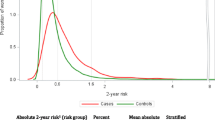Early detection is advocated widely as the best method to reduce the high rate of breast cancer mortality in women. The purpose of this study was to describe the detection histories of women with breast cancer and to identify factors related to the method of detection. During the period 1988–90, 3,197 women with invasive breast cancer, identified through the Wisconsin (United States) tumor registry, were interviewed. The method of cancer detection (classified as self, screening mammography, or clinical breast examination [CBE]) was analyzed using polychotomous logistic regression. Fifty-five percent (1,754/3,197) of the women found their own cancers, while 35 percent (1,122/3,197) were detected by screening mammography. Compared with self-detection, the likelihood of non-localized disease was significantly lower for tumors detected by mammography (odds ratio [OR]=0.3, 95 percent confidence interval [CI]=0.2–0.4) and CBE (OR=0.6, CI=0.4–0.7). The likelihood of cancer being detected by screening mammography increased with increasing age, education, number of prior mammograms, family history, and body mass index (weight/height2) (BMI). Women in the highest BMI quintile were 2.3 times (CI=1.7–3.0) more likely than women in the lowest BMI quintile to have their cancers diagnosed by mammography. This association most likely results from breast tumors being more difficult to palpate in heavier women.
Similar content being viewed by others
References
American Cancer Society. Cancer Facts and Figures-1993. Atlanta, GA (USA): American Cancer Society, 1993.
Harris JR, Lippman ME, Veronesi U, Willett W. Breast cancer (part 1). N Engl J Med 1993; 327: 319–28.
Shapiro S. Determining the efficacy of breast screening. Cancer 1989; 63: 873–80.
Tabar L, Fagerberg G, Duffy SW, et al. Update of the Swedish two-county program of mammographic screening for breast cancer. Radiol Clin North Am 1992, 30: 187–210.
Wald N, Frost C, Cuckle H. Breast cancer screening: the current position. Br Med J 1991; 302: 845–6.
Miller AB, Chamberlain J, Tsechkovski M. Self-examination in the early detection of breast cancer. J Chronic Dis 1985; 38: 527–40.
Morrison AS. Is self-examination effective in screening for breast cancer? JNCI 1991; 83: 226–7.
Newcomb PA, Weiss NS, Storer BE, et al. Breast self-examination in relation to the occurrence of advanced breast cancer. JNCI 1991; 83: 260–5.
Haagensen CD. Diseases of the Breast. 2nd Ed. Philadelphia, PA (USA): WB Saunders, 1971: 445–77.
Maharry JM. Carcinoma of the breast in a community hospital: who makes the diagnosis? Am J Obstet Gynecol 1980; 137: 207–11.
Hislop TG, Coldman AJ, Skippen DH. Breast self-examination: importance of technique in early diagnosis. Can Med Assoc J 1984; 131: 1349–52.
Nemoto T, Natarajan N, Smart CR, Mettlin C, Murphy GP. Patterns of breast cancer detection in the United States. J Surg Oncol 1982; 21: 183–8.
Newcomb PA, Storer BE, Longnecker MP, et al. Lactation and a reduced risk of premenopausal breast cancer. N Engl J Med 1994; 330: 81–7.
Miller BA, Ries LAG, Hankey BF, et al, eds. SEER Cancer Statistics Review: 1973–1990. Washington DC: US National Cancer Institute 1993; NIH Pub. No. 93–2789.
Fleiss JL. Statistical Methods for Rates and Proportions. 2nd Ed. New York, NY (USA): John Wiley, 1981.
Hosmer DW, Lemeshow S. Applied Logistic Regression. New York, NY (USA): John Wiley, 1989.
SAS Institute, Inc. SAS/STAT User's Guide. Release 6.03. The CATMOD Procedure. Cary, NC (USA): SAS Institute, Inc., 1988.
Lemeshow S, Hosmer DW. The use of goodness-of-fit statistics in the development of logistic regression models. Am J Epidemiol 1982; 115: 92–106.
Centers for Disease Control and Prevention. Trends in screening mammograms for women 50 years of age or older-Behavioral Risk Factor Surveillance System, 1987. MMWR 1989, 38: 137–40.
Centers for Disease Control and Prevention. Use of mammography—United States, 1990. MMWR 1990; 39: 621–30.
Farwell MF, Foster RS, Constanza MC. Breast cancer and earlier detection efforts—realized and unrealized impact on stage. Arch Surg 1993, 128: 510–3.
Eddy DM, Hasselblad V, McGivney W, Hendee W. The value of mammography screening in women under age 50 years. JAMA 1988; 259: 1512–9.
Remington PL, Lantz P. Mammography guidelines and practices in Wisconsin. Wisconsin Med J 1989; 88: 38–40.
Centers for Disease Control and Prevention. Mammography and clinical breast examinations among women aged 50 years and older—Behavioral Risk Factor Surveillance System, 1992. MMWR 1993; 42: 737–41.
Senie RT, Rosen PP, Lesser ML, Kinne DW. Breast self-examination and medical examination related to breast cancer stage. Am J Public Health 1981; 71: 583–90.
Greenwald P, Nasca PC, Lawrence CE, et al. Estimated effect of breast self-examination and routine physician examination on breast-cancer mortality. N Engl J Med 1978; 299: 271–3.
Gould-Martin K, Paganini-Hill A, Casagrande C, et al. Behavioral and biological determinants of surgical stage of breast cancer. Prev Med 1982; 11: 429–40.
Senie RT, Rosen PP, Lesser ML, Kinne DW. Method of tumor detection influences the prognosis of women with breast carcinoma. SER (Abstract). Am J Epidemiol 1993; 138: 670.
Foster RS, Costanza MC. Breast self-examination practices and breast cancer survival. Cancer 1984; 53: 999–1005.
Smith EM, Burns TL. The effects of breast self-examination in a population-based cancer registry. Cancer 1985; 55: 432–7.
Willett WC, Browne ML, Bain C, et al. Relative weight and risk of breast cancer among pre-menopausal women. Am J Epidemiol 1985; 122: 731–40.
Lantz PM, Remington PL, Cautley E. Identifying women who have never had a mammogram. Wisconsin Med J 1991; 90: 591–2.
Krischer JP, Cook B, Weiner RS. Identification and screening of women at high risk of breast cancer. Cancer Detect Prev 1988; 13: 65–74.
Kaplan KM, Weinberg GB, Small A, Herndon JL. Breast cancer screening among relatives of women with breast cancer. Am J Public Health 1991; 81: 1174–9.
Author information
Authors and Affiliations
Additional information
This work was undertaken while Dr Reeves was an Epidemic Intelligence Officer, assigned to the Wisconsin Division of Health from the Division of Field Epidemiology, Centers for Disease Control and Prevention, Atlanta, GA, USA.
Rights and permissions
About this article
Cite this article
Reeves, M.J., Newcomb, P.A., Remington, P.L. et al. Determinants of breast cancer detection among Wisconsin (United States) women, 1988–90. Cancer Causes Control 6, 103–111 (1995). https://doi.org/10.1007/BF00052770
Issue Date:
DOI: https://doi.org/10.1007/BF00052770




